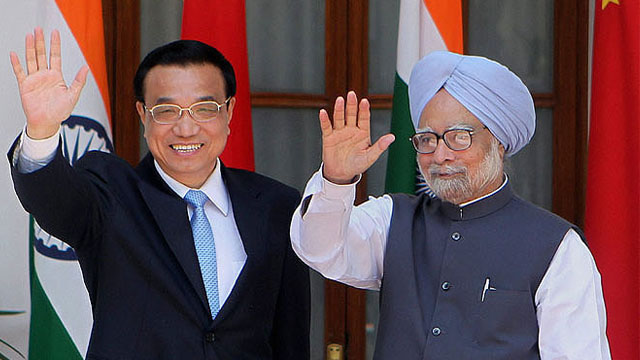Pleasantly, there seems to be an unprecedented resolve among the leadership of both countries to solve issues expeditiously.
Prime Minister Manmohan Singh’s three day visit to China has brought out insightful glimpses of the realignments taking place in the international arena. The Dragon and the Tiger have sought to reiterate that “we were not destined to be rivals, and we should show determination to become partners.”
Giving a greater thrust to their ties, Manmohan Singh outlined a new vision for the future of ties with China, detailing “seven practical principles of engagement” with his Chinese counterpart Li Keqiang. These principles remind us of Nehru-Zhou En-lai’s famous Panchsheel, but the difference between then and now are note-worthy.
While Nehru and En-lai sought to bake their relationship in idealism, Dr. Singh’s principles are more pragmatic and directed towards resolution of current issues. Naturally, greater sensitivity to core issues such as the boundary question and trans-border Rivers assumes greater importance under Dr. Singh’s vision of future bilateral relations.
The five other “principles ” outlined by Dr. Singh are: greater sensitivity to each other’s core concerns; “a spirit of transparency”; greater policy coordination on global matters; taking forward economic ties; and widening people-to-people contact.
The steps to give concrete shape to these principles have already been initiated. A Border Defence Cooperation Agreement (BDCA) to avoid face offs between the two armies along the disputed Line of Actual Control has been signed. Chinese Prime Minister Li Keqiang said that as many as nine pacts had been signed between the two countries.
The relationship between India and China, who together account for more than 40% of the global population, has important ramifications not only for Asia but also for the world at large. That both the countries are seen as engines of global economy in a gloomy environment makes this relationship all the more important.
There are two interesting facets to this unique relationship between two of the world’s oldest civilizations. Within South Asia, both China and India have their own spheres of influence and are seen as competitors, if not rivals.
Seen from this perspective, China’s coziness with Pakistan, including its massive investments in POK is a concern to India. Similarly, any Chinese involvement in South Asian affairs, be it Nepal, Maldives or Sri Lanka is a strict no-no for India. In the same vein, India’s increasing proximity to the USA, and its important position in the US “pivot to Asia” are seen in China as a strategy to contain Chinese influence. Further, with India seeking to vigorously pursue its “Look East” policy and its involvement, though oblique, in the South China Sea affair is seen as another manifestation of this competition.
This narrative of competition stands in stark contrast to the solidarity displayed by the two countries on almost all matters outside Asia. Their collective leadership in BRICS, cooperation on trade and investment in the WTO and on environmental issues portray a picture of camaraderie. It won’t be hyperbolic to argue that India and China constitute two vital pillars of the entire global south.
Seen in this backdrop of competition in Asia and cooperation outside, the developments during Dr. Manmohan Singh’s visit to China are noteworthy for the entire global diplomatic community. Both Dr. Singh and his Chinese counterpart have displayed a remarkable understanding of this dualism. As such, they have rightly sought to enhance their cooperation on global issues; and bridge the gap in their bilateral relations at the same time.
Since the problems are more on the bilateral front, this visit has focused more on the outstanding issues between the two countries. Important among these are skirmishes along the LOC, river disputes and visa issues. Other long standing issues include resolution of the boundary dispute, and the heavy trade imbalance that is cruelly unfavourable to India. While some of these issues can certainly be resolved quickly, the long standing issues require greater commitment and definitely more time.
Pleasantly, there seems to be an unprecedented resolve among the leadership of both countries to solve these issues expeditiously. The personal rapport Dr.Singh seems to enjoy with China’s new leadership is certainly conducive to this environment. A faster, durable and well thought solution to these issues will not only cement the bond between India and China, but also lend more weight to the voice of the Global South.





